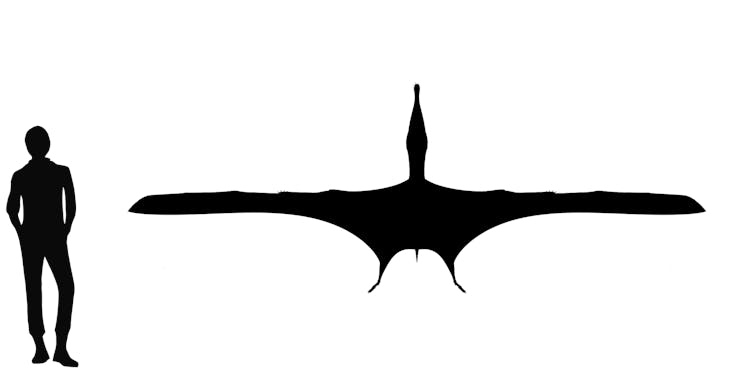


The English Cambridge Greensand Formation preserves a huge number of fragmentary pterosaur species, known mostly from isolated portions of their snouts. Camposipterus is a genus with three species – Camposipterus nasutus, C. sedgwickii, and C. colorhinus – once considered to be members of the genus Ornithocheirus. Although the three species were originally named in the 19th century, the genus Camposipterus was named in 2013 by Taissa Rodrigues and Alexander Kellner.
All three species are known only from snout bones, but are distinctive enough to demonstrate that they are different from other known species, and are probably closely related to each other. Camposipterus nasutus is known from a 15 cm (6 inch) portion of the end of the snout. It’s long and tapering without any crest, curves upward, and has a blunt end. When seen from above the snout is narrow and tapers toward the tip, but has a very slight spoon-like expansion near the tip.
There are 10 tooth positions on each side, although there may have been more beyond what is seen in the fossil. The first tooth position is at the tip of the jaw and appears to be oriented down and forward. The largest teeth are concentrated near the end of the jaws and become smaller and more widely spaced further back.
Camposipterus sedgwickii is known from a 7.5 cm (3 inch) portion from near the ends of the jaw. It preserves a smaller portion of the snout than C. nasutus, from tooth positions 2-7, and has a more prominent spoon-like expansion.
Camposipterus colorhinus is also known from a small snout fragment, only 6 cm (2.5 inches) long. The fragment preserves four tooth positions, with the first being directed forward and down, and the first three teeth being substantially larger that the fourth. The snout of C. colorhinus has two pits at the tip, just above the first two teeth.
Nothing more is known of the skeletons of any of the three species of Camposipterus, but comparison to relatives can allow rough estimates of their sizes. Both C. nasutus and C. sedgwickii may have had skulls around 50 cm (20 inches) long, and wingspans of about 3 meters (10 feet). C. colorhinus seems to have been larger, with a wingspan of perhaps 4 meters (13 feet).
Despite their fragmentary nature, Rodrigues and Kellner entered all three species into a phylogenetic analysis of pterosaurs. They found them to be ornithocheirids, similar to other basal ornithocheirids without snout crests. It should be noted that Rodrigues and Kellner use the name Anhangueria for essentially the same group we call Ornithocheiridae here at Pteros.
The Cambridge Greensand was deposited over 100 million years ago under the waves of a warm shallow sea. Camposipterus and the other ornithocheirids were aerial fishers, and may have soared great distances in search of food.
